
It all started late in
the Depression. Thinking back, I was perhaps 11 years old in 1933, my Dad
had passed away, my Mother was teaching school for $72.00 a month, and I saw
an itinerant sign painter letter the window on the local Barber Shop. He did
a "dynamite job"-- tinted varnish size, aluminum bronze powder rub, red &
black split shade, a beautiful thick and thin letter; on the door he did a
beautiful thick & thin script. It was the greatest thing I had ever seen.
He was an excellent sign painter trying to survive by working the road.
Right then I became the local sign painter
"self-appointed" in the little town of Avon in  central
Illinois, population 799.
central
Illinois, population 799.
Where I got my first brushes and paint I don't
recall, probably Woolworth's five and ten. I painted every flat surface I
could find -- including some solid walnut table leaves I found stored in my
grandparents' garage -- yes, aluminum and red.
During high school I lettered some trucks ($1
per door) and windows, including for a friend who had an office in the Bondi
building in Galesburg, Illinois, which at that time was the home of Dick
Blick Co., one of the first sign supply companies. Mister Blick heard
about me and invited me to visit his store. While there he gave me a complete
set of his Dick Blick Master Stroke Red Sable brushes and patted me on the
shoulder and said "Go to it." Mister Blick was a show card writer and window
trimmer for O. T. Johnson Company, and started his sign supply business
selling Hunt's Speedball Pens.
After high school I tried one semester of college,
but didn't enjoy what the Art Department had to offer. Again, it was Dick
Blick who suggested I go to Schmeby Institute in Minneapolis, Minnesota,
a trade school that taught card writing and window trimming. While I was up
there, a restaurant I visited had the most beautiful girl working there --
and you guessed it, we were married a few month later, after returning to
Illinois.
We moved to Peoria, Illinois in 1940 and ended
up in a union sign shop as an apprentice. I started at $15 per week, union
scale --- journeymen were getting $1.37½ per hour, or $11 a day.
There was the owner, one journeyman and myself.
I cleaned paint pots, dug holes, and built and coated signs. The journeyman
liked to play cards and he didn't drive, so I would drive him to the jobs.
If there was a pool hall in the neighborhood, he would lay out the sign and
I would paint it while he played cards. This was great practice. At this time,
after about a year as an apprentice I was earning $17.50 per week. The shop
was doing Coca Cola's privilege panels and I would watch how they were done.
One day Coke's sales manager came in for a
rush job. I was in the shop by myself and he asked if I could do the job.
I did my best and my effort must have pleased him: he asked how much I was
making, and offered me $135 per month, including a white Coke uniform.
WWII came next, and I ended up in the Coast
Guard in a graphics department at Manhattan Beach (Brooklyn) Naval Yard, making
flip charts for training aids, and lettering cabin doors, etc., on ships. I worked with a fine gentleman, Howard Schechterle,
who owned Ace Sign Company in Springfield, Massachusetts. Howard offered
me a job when I got out of military, but I didn't care for the East Coast.
I also met Lum Savage while in the service
-- he owned Savage Signs in Benton Harbor, Michigan - and Lum also
offered me work. I was discharged off the USS Monticello AP61, a troop transport,
and moved my family to Michigan late in '46 to work for Savage Sign Co. The
shop was primarily doing commercial sign work although Lum had a neon plant.
His tube bender Pete Hicks and I later
moved across the river and started Twin City Sign  Service in St. Joseph, Michigan. Pete
was also an excellent sign painter. We painted signs and fabricated our own
metal cans for neon signs. Our hanging equipment consisted of a gin pole hanging
off the edge of the building and a block and tackle for lifting -- no boom
trucks or ladder trucks; this was 1947.
Service in St. Joseph, Michigan. Pete
was also an excellent sign painter. We painted signs and fabricated our own
metal cans for neon signs. Our hanging equipment consisted of a gin pole hanging
off the edge of the building and a block and tackle for lifting -- no boom
trucks or ladder trucks; this was 1947.
By this time my wife Boots (short for Arbutus)
and I had two little boys, Rudy and Steve. The climate on Lake Michigan didn't
agree with my wife, so I sold out to my partner Pete and advertised my availability
in the Signs of the Times. Pete renamed the shop Hicks Neon.
There was plenty of work for a country sign painter and we settled on Raton
Sign Company in Raton, New Mexico, far from the Michigan wet. Don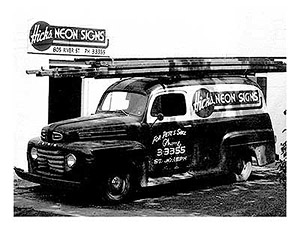 Partridge the owner was one nice man. He had bulletins on the highway
from Colorado Springs up north to Albuquerque, New Mexico south, and from
Texline, Texas east to Taos, New Mexico west. He also did commercial work
plus neon. We used to go on painting trips, five guys in two trucks -- drive
to the
Partridge the owner was one nice man. He had bulletins on the highway
from Colorado Springs up north to Albuquerque, New Mexico south, and from
Texline, Texas east to Taos, New Mexico west. He also did commercial work
plus neon. We used to go on painting trips, five guys in two trucks -- drive
to the 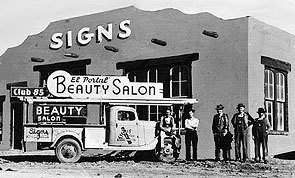 farthest board and work our way home -- usually these trips would
be about three days. This job entailed some pictorial work, and sometimes
we'd go downtown and gild the doctor's window.
farthest board and work our way home -- usually these trips would
be about three days. This job entailed some pictorial work, and sometimes
we'd go downtown and gild the doctor's window.
After about a year at Raton I was offered a
job at Colorado Springs Neon Company as a sketch artist.
I thought that would be neat, doing bench work all day. That was a mistake,
however; I didn't enjoy the constant sketch work. I don't recall, but I probably
wasn't in Colorado Springs more 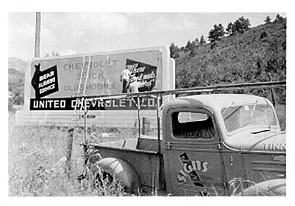 than six months. I could have gone back to Raton, but yearned to
get back to the Midwest, nearer to Boots' sisters in Minnesota and my mother
in Illinois.
than six months. I could have gone back to Raton, but yearned to
get back to the Midwest, nearer to Boots' sisters in Minnesota and my mother
in Illinois.
While we were in the west, I lettered a new
fire truck for a small town in New Mexico. Thirty-five years later, we were
traveling through there again, and on an impulse I stopped at the fire station.
In the back of the station they still had the old truck, still looking pretty
good. I doubt that any other work from  those days is as well preserved.
those days is as well preserved.
I advertised again and was offered a job at
Osgood Sign Company in Beloit, Wisconsin, halfway between Illinois
and Minnesota. Housing was difficult to find in Beloit, however, so my next
option was Wabnitz Sign Company in Louisville, Kentucky - a non union
shop paying 25¢ over scale. Lots of window valances and walls advertising
Hallinbach  and Buttermann Ice Cream.
and Buttermann Ice Cream.
As it turned out, I got fired from this job.
We were living in Clarksville, Indiana, across the Ohio River from Louisville.
I started thinking of leaving Wabnitz to go into business for myself in Clarksville
in the spring. I bought a new 1949 Chevrolet pickup, standard cab for $1299
to work out of when I went into business. I made the mistake of driving it
to work and the boss decided he would beat me to the punch: on the next Friday
payday he told me I didn't need to come in Monday. Believe me, that punctured
my balloon.
I tucked my tail and on Monday went to Billy
Smith Sign Company there in Louisville and asked if he needed a country sign painter.
He questioned me a little, asked where I been working and said for me to come
in the next day. Billy gave every new man the lousiest job he had in the shop.
If one went out and did it, (usually a beer sign on a rough brick wall) he
had it made. After the rough wall he put me on a 16' high cutout pictorial
beer bottle which I was able to cheat my way through. In 1951 while I was
on a job, another signwriter came over and introduced himself as Mr.Clay.
A few years later, I read that his son was a boxer for the U.S. in the Olympics.
(Yes, he was Muhammad Ali's
there in Louisville and asked if he needed a country sign painter.
He questioned me a little, asked where I been working and said for me to come
in the next day. Billy gave every new man the lousiest job he had in the shop.
If one went out and did it, (usually a beer sign on a rough brick wall) he
had it made. After the rough wall he put me on a 16' high cutout pictorial
beer bottle which I was able to cheat my way through. In 1951 while I was
on a job, another signwriter came over and introduced himself as Mr.Clay.
A few years later, I read that his son was a boxer for the U.S. in the Olympics.
(Yes, he was Muhammad Ali's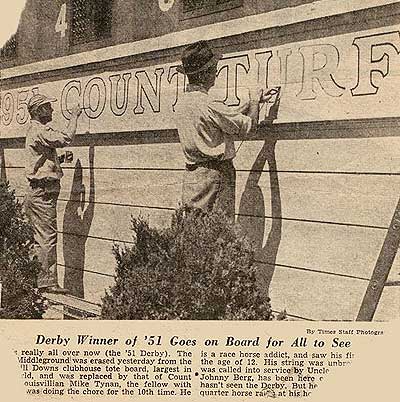 father.)
father.)
We did lots of work at Churchill Downs, home
the Kentucky Derby. Lots of gilding for the wealthy race horse owners. While
in Louisville I met Bill Lange, one of the finest sign painters I ever
met and a hell of a nice guy, who had a one man shop in the west end of Louisville.
He was versatile: he could do a 1½" matte center gold job on glass, and the
next day paint a Colgate logo on a city water tank. I used to help Bill after
hours and weekends.
Billy Smith paid over scale and treated me
well. It was an education working for him -- everything was a cut above, and
lots of variety. We had 4' x 36' canvas banners that were strung across the
streets to redirect traffic during Derby Days. Using long benches along one
wall, we would stretch a banner, coat it with a mix of whiting and fish glue
and letter it while it was still damp. The install crew would put them up
and remove them, and then they were sent to a commercial laundry and washed
and dried and put into storage for next year.  They weighed a ton -- far removed from the vinyl banners used today.
They weighed a ton -- far removed from the vinyl banners used today.
After a couple of years with Billy Smith I finally
opened my own business with that troublemaking truck, but before long I was
offered a job with General Outdoor Advertising Company in Peoria, Illinois.
This was all bulletin and wall work, but it was a chance to get back home
to where I had started. The job with G.O.A. was OK -- no pressure, two journeymen
working together. The union went on strike, though (I'd had to join the union
in Louisville).
While I was on strike I was offered a job at
Rhodes Display Company in Peoria. Rhodes manufactured industrial displays
for Caterpillar Tractor Co. and Dusty Rhodes, the owner, had signed
the new union contract so there wasn't any problem with the union.
It sounds strange, but I was able to execute
small letters rather well, even though I just came from a wall and bulletin shop. This job
was a pleasure: Dusty was a great airbrush artist and a grad from the University
of Nebraska with a degree in engineering and art -- therefore all the displays
we produced for Caterpillar were animated in some manner. Sometimes the crates
for the displays cost as much as the displays themselves, for they had to
provide protection during air shipments.
from a wall and bulletin shop. This job
was a pleasure: Dusty was a great airbrush artist and a grad from the University
of Nebraska with a degree in engineering and art -- therefore all the displays
we produced for Caterpillar were animated in some manner. Sometimes the crates
for the displays cost as much as the displays themselves, for they had to
provide protection during air shipments.
More than once Dusty would get an idea in the
middle of a  project for how it could be improved, and go off in that direction;
this could be costly and the profit picture would change. He was probably
one of the most talented individuals I ever had the pleasure of working with,
a great talent and a great guy. He even gave me a bonus on the 4th
of July one time.
project for how it could be improved, and go off in that direction;
this could be costly and the profit picture would change. He was probably
one of the most talented individuals I ever had the pleasure of working with,
a great talent and a great guy. He even gave me a bonus on the 4th
of July one time.
We lost Dusty back in the late 80's. He had
retired and moved to Roswell, New Mexico where he had a son and a daughter.
I should mention that while I was at Rhodes
I met Art Reed, a great craftsman and  improviser who could take the nuts & bolts from a
discarded Coca Cola vending machine and use them to make a tiny model Caterpillar
tractor push ground cork "earth" around a plaster mountain. "Hats off" to
Art Reed from Peoria, Illinois.
improviser who could take the nuts & bolts from a
discarded Coca Cola vending machine and use them to make a tiny model Caterpillar
tractor push ground cork "earth" around a plaster mountain. "Hats off" to
Art Reed from Peoria, Illinois.
When we had moved back to the Peoria area,
we located in a community about eight miles out, halfway between Peoria and
the neighboring town of Pekin. My wife would go to Pekin to shop, a town of
about 30,000 easier to get around than Peoria and she would mention, "What
a nice town." I had the urge to go back into business for myself and I would
say, "For two cents I would go over  to Pekin and go into business." (There was only one sign painter
operating in Pekin at that time.)
to Pekin and go into business." (There was only one sign painter
operating in Pekin at that time.)
Finally, I guess, my wife had given me as much
as $10.00, two cents at a time. One day I came home and she said, "I rented
you a shop in Pekin." It was a little 24 x 24 building for $25.00 per month.
That was the start of Johnny Berg Signs, Pekin, Illinois. Early on
I was able to get the Borden Ice Cream work: trucks, site signs, banners,
all types of commercial work. I didn't say no to anyone. It might be a hand
cut screen print job, whatever. I had eight bulletins on lease and business
took off.
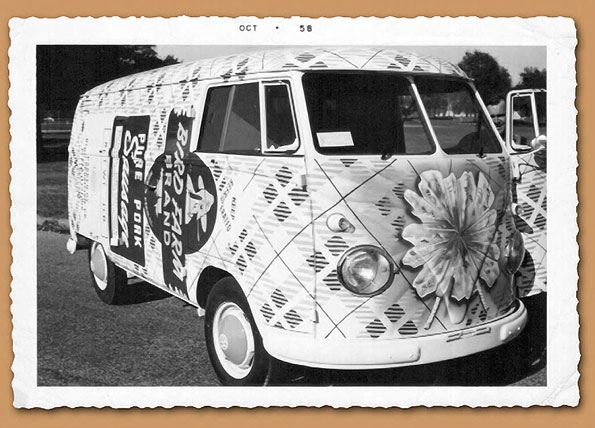
Business
got too good, but I was fortunate to hire a young man, Bob Kronke,
a Korea 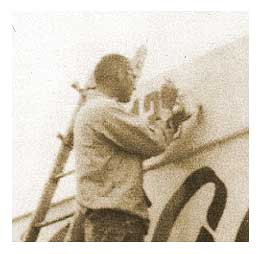 Vet who
was good help and very dependable as well as sober. After the business started
I made the mistake of relocating my shop so it was attached to our home. I
guess I wasn't a very good operator because customers were coming by at 10
o'clock at night, Borden salesman calling at 6 am, and I was spending evenings
making patterns, etc., getting ready for the next day. Boots was taking care
of office books, taxes, chasing material and being a great mom to a couple
of teenagers. But Kronke decided he had enough of cold Illinois winters and
decided to go to Tucson, Arizona. After that I was getting help from the Peoria
union.
Vet who
was good help and very dependable as well as sober. After the business started
I made the mistake of relocating my shop so it was attached to our home. I
guess I wasn't a very good operator because customers were coming by at 10
o'clock at night, Borden salesman calling at 6 am, and I was spending evenings
making patterns, etc., getting ready for the next day. Boots was taking care
of office books, taxes, chasing material and being a great mom to a couple
of teenagers. But Kronke decided he had enough of cold Illinois winters and
decided to go to Tucson, Arizona. After that I was getting help from the Peoria
union.
I advertised in Signs of Times for help,
and chose to investigate a gentleman, Arthur Lewis then in Canada who
was from England and needed employment to enter the U.S. Arthur and I  compromised
on his transportation costs to check us out. He was a great sign painter,
having been trained in England -- but I found that he could not work and talk,
and he loved to talk. . . .
compromised
on his transportation costs to check us out. He was a great sign painter,
having been trained in England -- but I found that he could not work and talk,
and he loved to talk. . . .
I was getting tired, Boots was getting tired
and the advertising director for American Distilling was negotiating to purchase
Rhodes Displays and go international with the display company. He was looking
for help and someone suggested he talk to me. During our discussion I asked
what I should do with my business if I was to go back to work for Rhodes.
He said he would buy Johnny Berg Signs.
I spent about six months at Rhodes, but what
used to come easy was now a struggle, and the end product I was producing
wasn't up to my standards. Finally, frustrated, I quit. The kids were  in college - it must have been about 1960. And Boots and I took
a trip to Arizona. While in Arizona I found out I had glaucoma, and my eyes
were the culprit that was affecting my work.
in college - it must have been about 1960. And Boots and I took
a trip to Arizona. While in Arizona I found out I had glaucoma, and my eyes
were the culprit that was affecting my work.
I got my eyes straightened out and back in
Peoria went to work for Hardin Sign Company. That's where Crazy
Jack Wills and I crossed paths. Jack was in his early stages and an  excellent student, and has turned out to
be a great sign painter - pin striper and designer.
excellent student, and has turned out to
be a great sign painter - pin striper and designer.
While working at Hardin's I think I painted
the largest one gold leaf letter I have seen. It was a large "U" located on
a large panel above the transom of a bank entrance about 70 miles from the
shop. All doors at the entrance with hours on them on the transom were large
letters: Union Savings Bank, single gild with black outline. Above that was
a large panel with this large U. I don't think I'm exaggerating when I say
it was probably 60" wide by 24" high. Black outline, burnished
gold outline lower 1/3 black, and varnish matt center for the upper two thirds,
matt center varnish, varnish clouded with a small amount of powdered litharge
and scrubbed with end of a quill handle. Single gild.
wide by 24" high. Black outline, burnished
gold outline lower 1/3 black, and varnish matt center for the upper two thirds,
matt center varnish, varnish clouded with a small amount of powdered litharge
and scrubbed with end of a quill handle. Single gild.
My wife and I had been visiting warmer climates
on our vacations, particularly Florida and Arizona. I had become acquainted
with sign shops in both areas -- Bob Nichols in Ocala, Florida and
Paul Millet in Mesa, Arizona. I always took my kit on these trips and
after a few days of acting like a tourist I would act as a guest artist in
these shops and work a few days.
With our sons in college, there was no reason
for my wife and me to stay in a cold climate, so we moved to Mesa, Arizona
in 1973. I had a job before we moved.
I was 50 years old, took the contractor's test,
posted the necessary bonds and thought I  would go into business. It was during this period I met Von Dutch
in Tempe, Arizona.
would go into business. It was during this period I met Von Dutch
in Tempe, Arizona.
In Mesa not much excitement happened sign-wise;
I never did go back into business, spent the next 12 yrs working in Mesa,
Tempe and Phoenix. I retired from sign writing at age 62 and my wife and I
ended up  dealing in Native American Arts & Crafts, primarily Navajo,
Hopi and Zuni Indian jewelry. We traveled in a motor home and worked various
shows.
dealing in Native American Arts & Crafts, primarily Navajo,
Hopi and Zuni Indian jewelry. We traveled in a motor home and worked various
shows.
Our home has been in Mesa, Arizona since 1973
and three years ago we found a small place in Eugene, Oregon where we summer.
We have a son, daughter-in-law, two granddaughters and three great-grandsons
in the Eugene area. Here is where I met my friend Vance Galliher, a
top-notch gold leaf artist.
 I'm not a stranger to the vinyl sign
business, although it came upon the scene about the time I was retiring.
I'm not a stranger to the vinyl sign
business, although it came upon the scene about the time I was retiring.
I could bore you with "interesting" stories
that happened in my travels, but I think I've said enough. There are a few
items for the Guinness book, though: the highest I ever worked on swing stage
was nine stories, I've also swung my butt in a bosun's chair, and lettered
the bottom of an (empty) swimming pool. . . .

Most of the guys
I worked with are no longer around: Dusty Rhodes, Bill Lange, Dick
Blick, Charles Eberhardt, Pete Hicks, Bill Boley, Toby Fitzgerald
-- believe me, there were a hell of a lot of good sign painters out there
that one never hears of.
Our sons are successful, one is an architect
in Eugene and one teaches at a university in Honolulu.
My wife Boots has been a marvelous partner,
mother and friend and we've been married nearly 63 years now. It's been a hell of
a ride; I've made a lot of mistakes over the past 81 years, but if I had another
chance I would do it again.
Best wishes and thanks for hearing me out.
![]()
7444 E. Abilene
Mesa, AZ 85208
480-981-9163
JJBerg77@aol.com 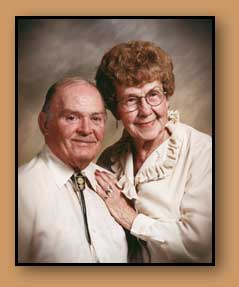
Website by Rudy & Steve Berg
